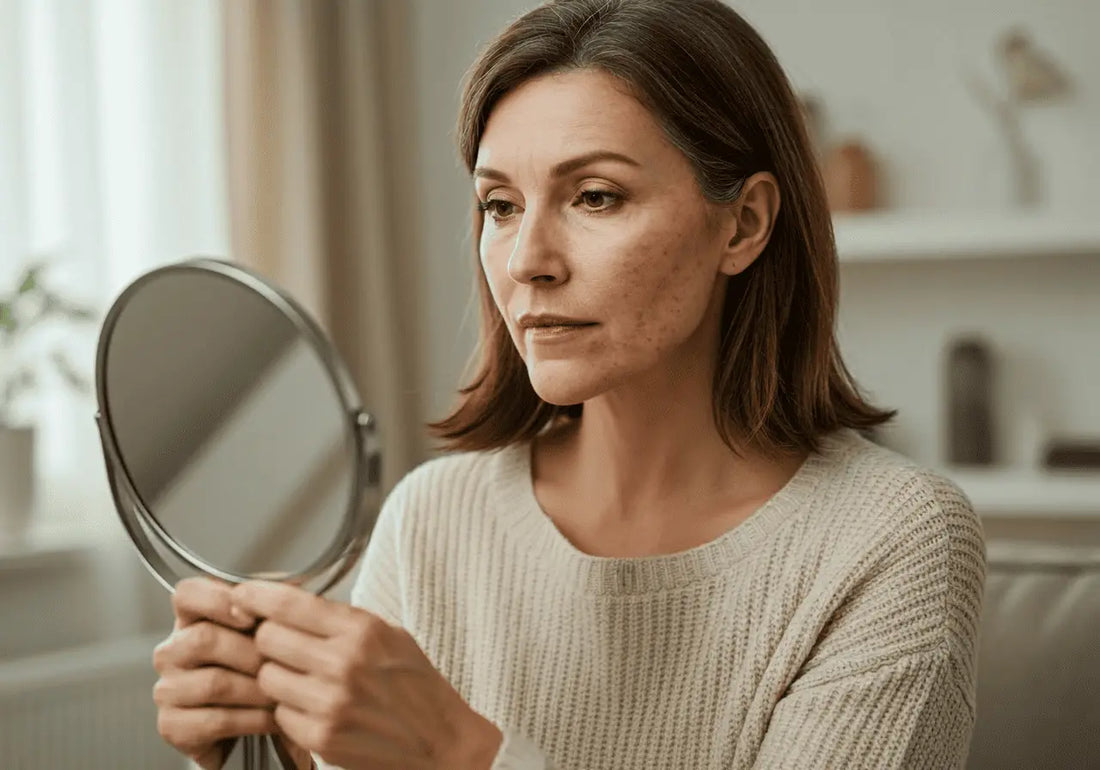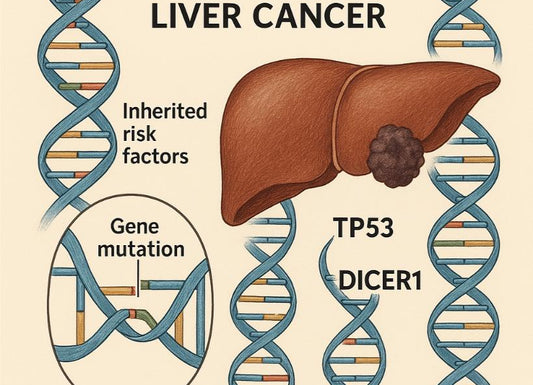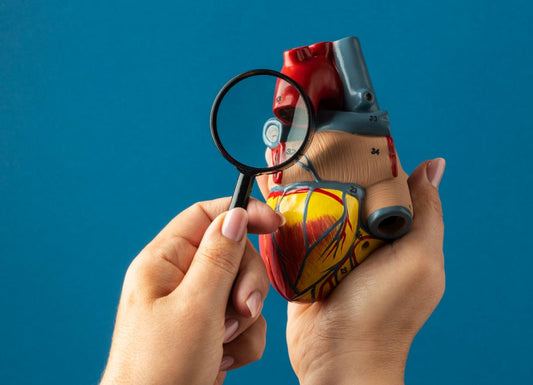What Does Liver Acne Look Like? A Clearer View of Skin and Liver Health
 Written By
Abel Tamirat, MD
Written By
Abel Tamirat, MD

Why your skin might be showing signs of liver trouble
Have you ever looked in the mirror and wondered why your skin, especially your face, is breaking out in painful, stubborn bumps that just won’t go away? Maybe you’ve already tried all the usual solutions: adjusting your skincare routine, cutting back on sugar, drinking more water. And still, those breakouts linger.
If that sounds familiar, it may be time to consider what’s happening beneath the surface. In some cases, persistent, treatment-resistant acne-like symptoms could point to deeper imbalances involving your liver.
“Liver acne” isn’t a formal medical term, but it’s a phrase people use when they suspect their breakouts are tied to poor liver function. While a true acne isn’t directly caused by liver disease, liver conditions can lead to skin symptoms that look and feel like acne, especially when hormonal or inflammatory factors are involved.
In this guide, we’ll help you explore what “liver acne” might actually be, how liver disease can show up on your skin, and what you can do about it.
What does liver acne look like?
Let’s start with the basics. The term “liver acne” often refers to acne-like skin issues that show up when something isn’t right with your liver. These can include:
-
Painful cysts or nodules under the skin, especially around the jawline, cheeks, or chin
-
Pimples that don’t respond to typical acne treatments like salicylic acid, benzoyl peroxide, or retinoids
-
Breakouts that worsen after alcohol use or eating greasy foods
-
Skin symptoms that appear with other liver signs, like fatigue, yellowing of the eyes, itching, or changes in nail color
It’s important to know that these signs don’t automatically mean you have liver disease. But they could point to deeper imbalances worth checking out, especially if you’re noticing other early signs of liver disease.
Why liver conditions may affect your skin

Your liver does a lot more than you might realize. It helps your body process food, filter toxins, balance hormones, and regulate cholesterol. When your liver isn’t working the way it should, the effects can ripple across many systems—including your skin.
Conditions like nonalcoholic fatty liver disease (NAFLD), alcohol-related liver disease, hepatitis, and cirrhosis can all trigger hormonal, metabolic, and inflammatory changes. These changes can lead to:
-
Hormonal imbalances, which can increase oil production and trigger acne-like breakouts
-
Buildup of toxins that your liver can’t filter properly
-
Immune system changes that show up on your skin as rashes, redness, or bumps
-
Nutrient deficiencies (especially zinc, vitamin A, and E) that affect your skin’s healing process
Certain conditions like anemia and liver disease may also play a role.
Common skin signs linked to liver health
So, what exactly might your skin be trying to tell you about your liver?
Here are some of the most common skin symptoms seen in liver disease—some of which can be mistaken for acne or occur alongside it.
1. Spider veins (spider angiomas)
These look like tiny red spots with little blood vessels radiating outward—like a spider’s legs. They often appear on the face, chest, and arms. While a few are normal, multiple spider angiomas can signal liver issues, especially in people with cirrhosis.
2. Eruptive xanthomas
These are small, yellowish bumps caused by high blood fat levels. They usually show up on the elbows, knees, or buttocks and are linked to fatty liver disease and cholesterol problems.
3. Pruritus (itchy skin)
About 40–60% of people with chronic liver disease experience itching, especially on the hands and feet. It’s often worse at night and may appear without a rash. Over time, scratching can lead to nodules that look like acne but aren’t.
4. Jaundice (yellowing of the skin and eyes)
This is one of the most recognized signs of liver dysfunction. Jaundice happens when bilirubin builds up in the body due to poor liver function. The skin may look yellowish, and the whites of the eyes might turn a deep yellow or even greenish tint.
5. Palmar erythema (red palms)
Also known as "liver palms," this is a reddening of the palms, especially near the base of the thumb. It’s caused by hormonal changes in the bloodstream—mainly higher estrogen levels.
6. Pigmentation changes
People with cirrhosis may develop a muddy or grayish skin tone, especially on the face. Dark patches may appear on the legs or ankles due to poor blood flow and pigment buildup.
7. Xanthelasma
These are yellowish plaques around the eyelids, caused by cholesterol deposits under the skin. They often appear in people with cholestatic liver diseases or lipid imbalances.
8. Clubbing and nail changes
Look at your fingernails: white nail beds (called Terry’s nails), half-and-half nails, or red lunula (the half-moon at the base) can all be subtle signs of liver disease.
How liver-related skin changes can mimic acne
Many of these liver-related skin symptoms don’t start out looking like traditional acne—but some can be mistaken for it:
|
Liver-Related Sign |
Why It Gets Confused With Acne |
|
Spider angiomas |
Small, red, pimple-like spots—especially on the face |
|
Eruptive xanthomas |
Raised, yellow bumps that resemble pus-filled pimples |
|
Prurigo nodularis |
Itchy, crusty nodules caused by scratching |
|
Pustular vasculitis |
Red papules and pustules, often mistaken for inflammatory acne |
If your skin is reacting in unusual ways and the treatments you’ve tried aren’t working, it might be time to consider what else could be going on under the surface.
When to talk to your doctor

You know your body best. If you’ve been noticing persistent skin problems that just don’t add up, it’s a good idea to talk to your healthcare provider—especially if you have other symptoms that may point to liver issues, such as:
-
Yellowing of your skin or eyes
-
Itching that doesn’t go away
-
Swelling in your legs, feet, or belly
-
Fatigue or brain fog
-
Dark urine or pale stool
-
Easy bruising or bleeding
Your doctor may recommend liver function tests (LFTs) or imaging like an ultrasound or FibroScan to check your liver’s condition. If needed, they might refer you to a liver specialist (hepatologist) or dermatologist.
But remember, liver function tests can be normal with cirrhosis in some cases.
Ways to support your liver—and your skin

The good news? Your liver is a resilient organ. With the right care and lifestyle changes, you can improve both liver health and skin health over time and begin to see signs your liver is healing.
Here’s what may help:
1. Eat liver-friendly foods
Focus on a diet rich in fiber, antioxidants, and healthy fats. Try:
-
Leafy greens (spinach, arugula)
-
Cruciferous veggies (broccoli, cabbage)
-
Healthy fats (avocados, olive oil)
-
Berries and citrus fruits
-
Whole grains
-
Fatty fish (salmon, sardines)
These help reduce inflammation and support liver detoxification.
Check out this science-based guide on how to detox your liver safely and effectively.
2. Cut back on sugar, alcohol, and processed foods
Sugar and alcohol are two of the biggest stressors for your liver—and your skin. Reducing or eliminating them can make a major difference.
3. Stay hydrated
Your liver and kidneys work together to clear waste. Staying well-hydrated helps both do their jobs better.
4. Exercise regularly
Even a brisk 30-minute walk a day can help reduce liver fat, improve insulin resistance, and boost circulation to your skin.
Research shows exercise helps liver cirrhosis and overall metabolic health.
5. Use gentle skincare
Avoid harsh products and opt for fragrance-free, non-comedogenic (won’t clog pores) cleansers and moisturizers. If you’re experiencing itching, a cool compress or colloidal oatmeal bath may help.
6. Consider helpful supplements (if your doctor agrees)
Talk with your provider before starting anything new. Some people with liver issues benefit from:
-
Milk thistle (silymarin) – supports liver cell regeneration
-
N-acetylcysteine (NAC) – precursor to glutathione, a major antioxidant. You can also explore what vitamins help liver repair to further support recovery.
-
Omega-3 fatty acids – reduce inflammation
7. Manage your stress
Chronic stress can worsen both liver and skin symptoms. Mindfulness, therapy, or relaxation exercises can support healing on all fronts.
You can read more on Does stress cause elevated liver enzymes?
Takeaway: Listen to your skin, support your liver
Your skin is smart. It often gives you clues when something’s going on inside your body. If you’re dealing with acne that’s deep, persistent, or showing up with other symptoms like itching, yellowing, or fatigue, it’s okay to wonder if your liver might be involved.
While “liver acne” isn’t an official diagnosis, the way your liver functions—or doesn’t—can absolutely affect how your skin behaves. By taking steps to support both, you’re giving your body what it needs to heal from the inside out.
Noticing breakouts that won’t go away? Ribbon Checkup’s at-home liver health test helps you track key liver function markers to see if your skin symptoms might be connected to what’s happening inside. Stay informed, stay ahead.
Related resources
-
Fatty Liver Symptoms on Face: A Comprehensive Guide
Understand how liver issues can manifest as facial acne, discoloration, and other skin changes. -
At-Home Liver Tests: A Comprehensive Guide
Explore how at-home testing can help you track liver health and identify issues before they surface externally. -
Early Detection of Liver Disease
Spot the warning signs of liver disease early—before they become visible on your skin.
References
A. Koulaouzidis, Bhat, S., & J. Moschos. (2007). Skin manifestations of liver diseases. Annals of Hepatology, 6(3), 181–184. https://doi.org/10.1016/s1665-2681(19)31926-x
Amandolare, S. (2024, December 31). Fatty Liver Symptoms on the Face. Retrieved May 25, 2025, from WebMD website: https://www.webmd.com/fatty-liver-disease/fatty-liver-face
Bhandari, A., & Mahajan, R. (2021). Skin Changes in Cirrhosis. Journal of Clinical and Experimental Hepatology, 12(4), 1215–1224. https://doi.org/10.1016/j.jceh.2021.12.013
Liu, Y., Zhao, Y., Gao, X., Liu, J., Ji, F., Hsu, Y.-C., … Nguyen, M. H. (2022). Recognizing skin conditions in patients with cirrhosis: a narrative review. Annals of Medicine, 54(1), 3016–3028. https://doi.org/10.1080/07853890.2022.2138961
Liver Disease: Signs & Symptoms, Causes, Stages, Treatment. (2017, March 7). Retrieved May 25, 2025, from Cleveland Clinic website: https://my.clevelandclinic.org/health/diseases/17179-liver-disease
Pedersen, T. (2024, May 3). Can Fatty Liver Cause Symptoms on The Skin? Retrieved May 25, 2025, from Healthline website: https://www.healthline.com/health/fatty-liver-symptoms-on-skin

Dr. Abel Tamirat is a licensed General Practitioner and ECFMG-certified international medical graduate with over three years of experience supporting U.S.-based telehealth and primary care practices. As a freelance medical writer and Virtual Clinical Support Specialist, he blends frontline clinical expertise with a passion for health technology and evidence-based content. He is also a contributor to Continuing Medical Education (CME) programs.



